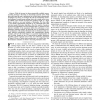Free Online Productivity Tools
i2Speak
i2Symbol
i2OCR
iTex2Img
iWeb2Print
iWeb2Shot
i2Type
iPdf2Split
iPdf2Merge
i2Bopomofo
i2Arabic
i2Style
i2Image
i2PDF
iLatex2Rtf
Sci2ools
118
click to vote
TASLP
2011
2011
Estimating Dominance in Multi-Party Meetings Using Speaker Diarization
—With the increase in cheap commercially available sensors, recording meetings is becoming an increasingly practical option. With this trend comes the need to summarize the recorded data in semantically meaningful ways. Here, we investigate the task of automatically measuring dominance in small group meetings when only a single audio source is available. Past research has found that speaking length as a single feature, provides a very good estimate of dominance. For these tasks we use speaker segmentations generated by our automated faster than real-time speaker diarization algorithm, where the number of speakers is not known beforehand. From user-annotated data, we analyze how the inherent variability of the annotations affects the performance of our dominance estimation method. We primarily focus on examining of how the performance of the speaker diarization and our dominance tasks vary under different experimental conditions and computationally efficient strategies, and how this ...
Dominance Estimation | Dominance Estimation Method | Software Engineering | Speaker Diarization | TASLP 2011 |
Related Content
| Added | 15 May 2011 |
| Updated | 15 May 2011 |
| Type | Journal |
| Year | 2011 |
| Where | TASLP |
| Authors | Hayley Hung, Yan Huang, Gerald Friedland, Daniel Gatica-Perez |
Comments (0)

